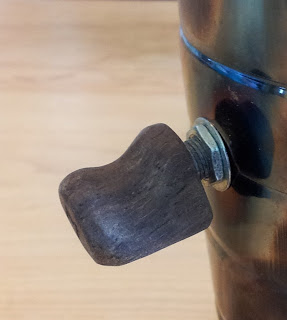Last year was our second annual apple day where we gather up a bunch of friends and grind apples, press cider. It was a good year for apples, we bought and gleaned many large containers from around the countryside.
On the big day, everyone assembled and we set to work. We hadn't found a grinder, so our plan was to just cut them up small and use a grape press
like this one to press the juice out. Apples are much tougher than grapes. We got no juice.
We had enough people there that someone knew someone else with an apple grinder, however it was a completely manual one of terrible design. It took a crew of strong people to operate. One to crank, the other to smash with a hunk of plywood and 2 to hold the whole thing down.
Things were not looking good, so we set up a second team to use a food processor to sliver the apples.
In the end, we did manage to make 78L of cider, but promised to have a better system next year. I did some research, and came across
this page on the importance of the grinding process.
To press apples, you have to break all of the cell walls first. After that the pressing is easy.
With that in mind, we set out to design a grinder. We had many ideas, most scary and dangerous, some involving stacked saw blades, like a dado, but as wide as an apple.
We settled on making something like the grater attachment on a food processor, except made out of slots for more grinding and less slicing.

First we had to turn our square piece of salvaged aluminum into something round.

We got the initial shape using a circle cuter, but eventually had to switch to the milling machine to remove the bulk of the material.

We then carved 6 slots in the face, drilled and taped the back side to fit into Nigel's large grinder.

We then tried it out, with less than successful results. The apple seemed to be just floating on the flat parts, with almost no grinding. The little bit of juice it did produce however was encouraging, as it covered the ground, fence and my shirt in a fine apple mist.
Back to the milling machine, we carved out much more, making many more ridges and also machining down the back sides, like a drill bit.

Now we had something. We then wiped together an enclosure of pipe. The apples are fed through the upper port on the left of the photo and a stick is used to push them into the impeller through the lower port. We screwed a bunch of wood screws into the end of the stick to stop the apples from spinning.
Note the bowl full of apple pulp.
This seems to work really well. We'll put a longer pipe on the apple chute for more capacity in the bin. The plunger keeps them all from falling in at once, when one apple is done, simply pull it out to load the next apple.

So far we are really happy with how it's turned out. We can process 1 apple every 3.5 seconds and the pulp is nearly perfect. The seeds stem and skin are left mostly intact while 95% of the meat is rendered into a pulp of juice and fiber, perfect for pressing.








































